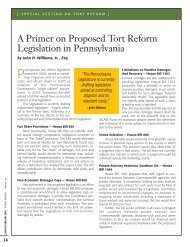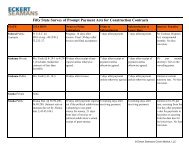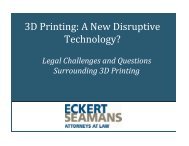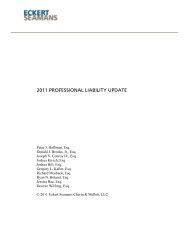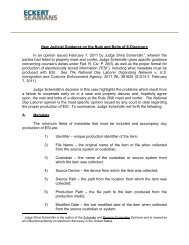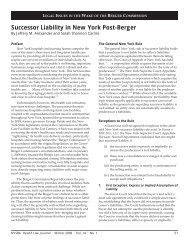Barbados had enough litigation-specific contacts with Pennsylvania to justify the exercise ofpersonal jurisdiction where the hotel sent mailings and Plaintiff, who fell off a massage tablewhile at the hotel, had made her reservation for the massage at the hotel after receiving one ofthe brochures.For additional venue cases not involving medical malpractice, see Zampana-Barry v.Donaghue, 921 A.2d 500 (Pa. Super. Ct. 2007), appeal denied, 940 A.2d 366 (Pa. 2007)(discussed in detail in the “Legal Malpractice” section of these materials); Walls v. The PhoenixIns. Co., 979 A.2d 847 (Pa. Super. Ct. 2009) (holding defendant failed to present sufficientevidence in forum non conveniens petition to demonstrate that venue in Philadelphia was bothoppressive and vexatious such that case should be transferred to Monroe County); McMillan v.First Nat’l Bank of Berwick, 978 A.2d 370 (Pa. Super. Ct. 2009) (holding trial court did notabuse its discretion in finding that proper venue in malicious prosecution case against bank wasin county where bank brought underlying claim against plaintiff).3. Other Rulesa. New/Amended Rules of Civil Procedure - Effective Since LastUpdatei. New Pennsylvania Rule of Civil Procedure 234.2 --Effective September 1, 2009Entitled “Subpoena. Issuance. Service. Compliance. Fees. Prisoners.”, this rule addressesthe issuance and service of a subpoena. The amendment affords greater protection to minors.ii. New Pennsylvania Rule of Civil Procedure 1036.1 --Effective March 1, 2009By Order dated January 22, 2009, Rule 1036.1, entitled “Reinstatement of ClaimDismissed Upon Affidavit of Noninvolvement, was created, to become effective March 1, 2009.The Rule sets forth the procedure for a party to reinstate a claim that has been dismissed throughan affidavit of non-involvement.Rule 1036.1 provides that if a party is dismissed through an affidavit of noninvolvementpursuant to Rule 1036, any party can file a motion to reinstate the dismissed party. The motionto reinstate must set forth facts showing that the statements made in the affidavit ofnoninvolvement were false or inaccurate. Any party can respond to the motion to reinstate.After the court reviews the motion and responses, if the court determines there is a primafacie case of involvement of the dismissed party, the court shall enter an order allowing anyparty to either: (1) conduct limited discovery solely regarding the involvement of the dismissedparty, and (2) file affidavits, depositions and other evidence that would allow a jury to find thatthe dismissed party was involved in the actions upon which the claim is based. Additionally, thecourt shall schedule an argument to decide the motion, limiting the sole issue to whether themoving party has produced evidence, that when considered in a light most favorable to the136
moving party, would require the issue of the involvement of the dismissed party to be submittedto a jury.D. The Fair Share Act – Changes To 42 Pa.C.S.A §7102On Tuesday, June 28, 2011, Pennsylvania Governor Tom Corbett signed into lawSenate Bill 1131, or the “Fair Share Act.” The Act had been adopted in the House ofRepresentatives the day before by a 116-83 vote, and had passed in the Senate the weekprior by a 32-18 vote. The Act passed was an amended version of House Bill 1, which theHouse had passed in April of 2011. The Act amends Title 42 of the PennsylvaniaConsolidated Statutes section 7102, and applies to causes of action which accrue on or afterthe effective date of the Act, June 28, 2011.Pennsylvania’s Fair Share Act abolishes most forms of joint and several liability,which had been the law in Pennsylvania civil cases prior to the Act’s passage. Under jointand several liability, a defendant with as little as one percent fault could be required to paythe share of a verdict that a co-defendant could not afford, no matter what percentage ofliability was assessed to both, then leaving it up to the paying-defendant to seek repaymentfrom the non-paying defendant.Under the Fair Share Act, most liability is several, but not joint. This means that anindividual defendant will only be responsible for damages proportionate to his share of thejudgment, as determined by the jury. However, if a defendant is determined to be liable forsixty percent or more of the total liability of all the defendants, this defendant could bejointly liable for all of the damages owed to the injured party.The Fair Share Act has four exemptions:1) a suit including an intentional misrepresentation;2) a case of intentional tort;3) a suit concerning the release or threatened release of a hazardous substanceunder the Hazardous Sites Cleanup Act; and4) a civil action in which a defendant has violated section 487 of the LiquorCode.The Act also states that the fact that a plaintiff is found to be contributorilynegligent will not bar the plaintiff’s recovery where the plaintiff’s negligence is not greaterthan the negligence of the defendant(s). However, damages awarded to the plaintiff will bediminished by the amount of negligence attributed to the plaintiff.Finally, the Act states that for purposes of apportioning liability only, uponappropriate requests and proof, the jury will decide the question of the liability of adefendant or third party who entered into a release with the plaintiff. The defendantrequesting the apportioning of that settling defendant or third party’s liability must,however, prove the liability. An exception is an employer protected with immunitypursuant to the Worker’s Compensation Act.137
- Page 3 and 4:
EMTALA CASES ......................
- Page 5:
Filing an Affidavit of Non-Involvem
- Page 8 and 9:
II.PROFESSIONAL LIABILITY - AN OVER
- Page 10 and 11:
The Superior Court reversed the tri
- Page 12 and 13:
to a third party pursuant to the st
- Page 14 and 15:
After approximately five months, De
- Page 16 and 17:
learned the day after the surgery t
- Page 18 and 19:
conduct to the delay in colon cance
- Page 20 and 21:
court admitted the expert’s testi
- Page 22 and 23:
(b)(c)other reasonable causes, incl
- Page 24 and 25:
corroborated his testimony. The cou
- Page 26 and 27:
husband’s estate. Plaintiff alleg
- Page 28 and 29:
Other notable federal cases arising
- Page 30 and 31:
The Superior Court found that in re
- Page 32 and 33:
§ 1303.512(b). The court, however,
- Page 34 and 35:
In Neidig v. United States, No. 07-
- Page 36 and 37:
Additionally, the Supreme Court not
- Page 38 and 39:
were not indicated for her conditio
- Page 40 and 41:
surgeon is the same as it would be
- Page 42 and 43:
It should be noted that the Superio
- Page 44 and 45:
Finally, the court held that the tr
- Page 46 and 47:
The Supreme Court of Pennsylvania r
- Page 48 and 49:
nurses deviating from applicable st
- Page 50 and 51:
certainty, the court reviews expert
- Page 52 and 53:
Under Pennsylvania law, the Court n
- Page 54 and 55:
testimony, Defendant presented his
- Page 56 and 57:
Following Cooper v. Roberts, 286 A.
- Page 58 and 59:
Plaintiff developed chronic diarrhe
- Page 60 and 61:
where payment is made by Medicaid w
- Page 62 and 63:
accomplished. In Valles v. Albert E
- Page 64 and 65:
In 1980, the Pennsylvania Superior
- Page 66 and 67:
Plaintiff had a routine monitoring
- Page 68 and 69:
Plaintiff’s Contract ClaimsThe Co
- Page 70 and 71:
is a failure to report changes in a
- Page 72 and 73:
unit to assure post-surgical patien
- Page 74 and 75:
sliced his wrist and arm with a raz
- Page 76 and 77:
licensed professionals for whom the
- Page 78 and 79:
(c)Limitations of Corporate Neglige
- Page 80 and 81:
Even more recently, our Superior Co
- Page 82 and 83:
(a)HMO IssuesIn McClellan v. Health
- Page 84 and 85:
affidavit submitted by Defendants o
- Page 86 and 87:
treatments while at VA’s faciliti
- Page 88 and 89:
[s]ubstantively, we believe that a
- Page 90 and 91:
The party claiming the benefit of t
- Page 92 and 93: deprive (him) of civil rights guara
- Page 94 and 95: found that the District Court was w
- Page 96 and 97: With respect to fraudulent concealm
- Page 98 and 99: would be applied in situations wher
- Page 100 and 101: they had not raised them in the cou
- Page 102 and 103: (a)Informed ConsentUnder MCARE, a p
- Page 104 and 105: civil enforcement provisions and ma
- Page 106 and 107: MCARE also changes the manner in wh
- Page 108 and 109: whose death, in 2005, was allegedly
- Page 110 and 111: vicariously liable if the plaintiff
- Page 112 and 113: health center or its equivalent or
- Page 114 and 115: In Pennsylvania Medical Society, th
- Page 116 and 117: to any professional who is alleged
- Page 118 and 119: Since the 2005 amendments, there ha
- Page 120 and 121: ule, but who intentionally ignores
- Page 122 and 123: the original Complaint was delivere
- Page 124 and 125: foreclose all challenges against th
- Page 126 and 127: number of boxes), which was support
- Page 128 and 129: questions of professional judgment
- Page 130 and 131: deviated from any professional stan
- Page 132 and 133: The Third Circuit affirmed the Dist
- Page 134 and 135: claims and cross-claims remain agai
- Page 136 and 137: By an Amendatory Order dated March
- Page 138 and 139: The court acknowledged that there i
- Page 140 and 141: apply and that the trial court misa
- Page 144 and 145: E. Preemption of Vaccine Design Def
- Page 146 and 147: 2. Pa. R. Civ. Pro. 1036.1 - Reinst
- Page 148 and 149: Barrick, at *34-35.Furthermore, the
- Page 150 and 151: (b) the utility of the defendant’
- Page 152 and 153: 2006). In this case, Plaintiffs bro
- Page 154 and 155: B. Elements of a Cause of Action fo
- Page 156 and 157: decision in Muhammad precluded Mr.
- Page 158 and 159: considered speculative “only if t
- Page 160 and 161: underlying cause of action involved
- Page 162 and 163: In Capital Care Corp., the Superior
- Page 164 and 165: The court found, however, to state
- Page 166 and 167: of reasonable diligence. The standa
- Page 168 and 169: not be set aside. On July 7, 2005,
- Page 170 and 171: complete bar to recovery. Since a l
- Page 172 and 173: On appeal, Plaintiffs claimed that
- Page 174 and 175: In Liggon-Redding, 659 F.3d at 265,
- Page 176 and 177: elieved of those minimum standards
- Page 178 and 179: elevant to the proceedings, the com
- Page 180 and 181: establish professional misconduct b
- Page 182 and 183: Upholding the Superior Court’s Or
- Page 184 and 185: Id.Rejecting revocation and suspens
- Page 186 and 187: order as a sanction under Rule 4019
- Page 188: {1009912]182



